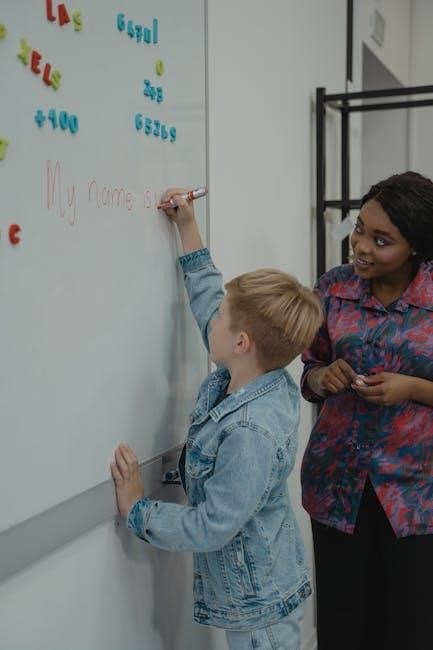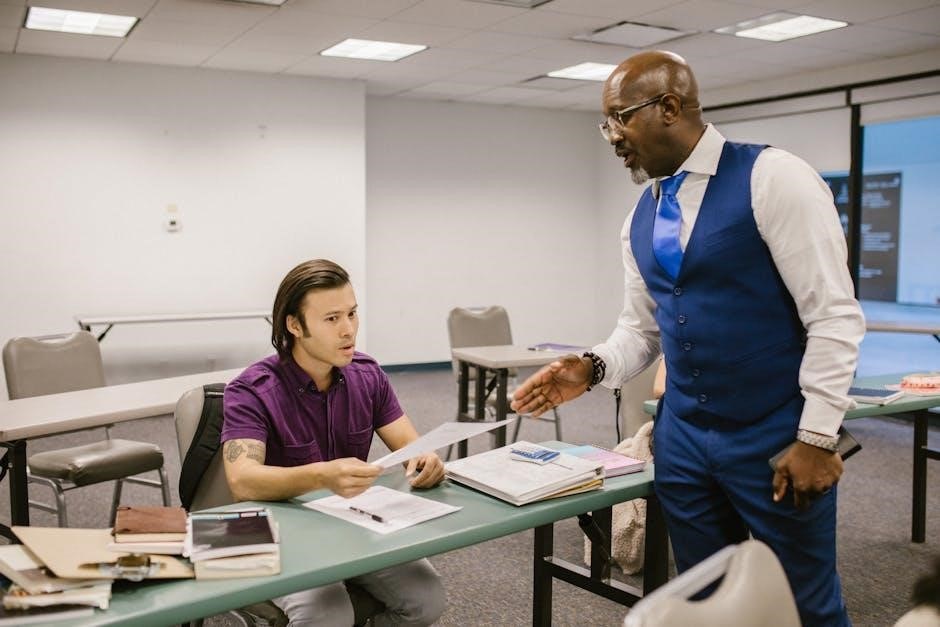teacher assistant interview questions and answers pdf
A Teaching Assistant plays a vital role in supporting teachers and students, ensuring a productive learning environment․ Their responsibilities include preparing materials, assisting with lessons, and providing individualized student support․ This role is essential for fostering academic growth and inclusivity in classrooms․ Understanding the duties and expectations is crucial for excelling in this position․
1․1 Overview of the Teaching Assistant Position
A Teaching Assistant supports teachers in creating an engaging and inclusive learning environment․ Key responsibilities include preparing materials, assisting with lessons, and providing individualized support to students․ They also help manage classroom behavior, facilitate group activities, and adapt lessons for diverse learning needs․ The role requires strong communication skills, patience, and the ability to work collaboratively with both students and educators․ Teaching Assistants play a crucial role in enhancing student outcomes and ensuring a smooth-running classroom․
1․2 Key Responsibilities of a Teaching Assistant
The key responsibilities of a Teaching Assistant include supporting teachers with lesson planning, preparing educational materials, and assisting students with their tasks․ They help manage classroom behavior, provide individualized support to students, and facilitate group activities․ Additionally, they may adapt lessons for students with diverse learning needs and assist with record-keeping․ Effective communication and collaboration with teachers are essential to ensure a productive learning environment․ The role also involves being adaptable and proactive in addressing student needs, contributing positively to their academic and personal growth․
Common Teaching Assistant Interview Questions
Common Teaching Assistant interview questions focus on understanding your motivation, strengths, and experience․ Questions like “Why do you want to be a Teaching Assistant?” and “What are your strengths for this role?” are frequently asked․ These questions help assess your passion for education, ability to support students, and readiness to collaborate with teachers effectively in the classroom environment, ensuring you align with the school’s values and goals․
2․1 Why Do You Want to Be a Teaching Assistant?
This question allows you to express your passion for education and supporting students․ Highlight your desire to contribute to a positive learning environment, collaborate with teachers, and assist students in achieving their academic and personal goals․ Emphasize your enthusiasm for working with children, your commitment to fostering growth, and any relevant experiences that align with the role․ Showcase your dedication to making a meaningful impact in education and your readiness to support both teachers and students effectively in the classroom․
2․2 What Are Your Strengths for This Role?
Your strengths should align with the requirements of a Teaching Assistant role․ Highlight your ability to communicate effectively with students and teachers, your organizational skills, and your patience in supporting diverse learning needs․ Emphasize your adaptability in managing classroom dynamics and your commitment to fostering a positive learning environment․ Showcase your ability to work collaboratively as part of a team and your dedication to helping students achieve their full potential․ These qualities demonstrate your readiness to excel as a Teaching Assistant and contribute meaningfully to the educational setting․
2․3 Walk Me Through Your Resume
When discussing your resume, highlight relevant experience working with children or in educational settings․ Emphasize roles where you supported learning, managed classroom activities, or assisted teachers․ Mention any training or certifications related to education or special needs․ Showcase skills such as communication, organization, and patience․ Provide specific examples of how you contributed to student growth or supported educators․ Tailor your narrative to align with the Teaching Assistant role, demonstrating your suitability and enthusiasm for the position․ Keep your explanation clear, concise, and focused on achievements and qualifications․

Classroom Management and Support
A Teaching Assistant supports classroom management by helping maintain a positive environment, preparing resources, and reinforcing teacher strategies․ They assist with behavior management, ensuring students stay focused and engaged․
3․1 How Do You Support a Teacher in Managing Classroom Behavior?
Supporting classroom behavior involves assisting teachers in creating a structured and respectful environment․ This includes setting clear expectations, using visual reminders, and reinforcing positive behavior․ Teaching assistants help monitor student actions, redirect misbehavior, and provide individual support to students who need it․ By maintaining a proactive approach, they ensure the teacher can focus on instruction while minimizing disruptions․ Effective communication with the teacher and students is key to fostering a calm and focused classroom atmosphere․
3․2 Strategies for Maintaining a Positive Learning Environment
Maintaining a positive learning environment requires a combination of proactive strategies․ Encouraging open communication, active listening, and empathy helps build trust among students․ Teaching assistants can promote positivity by recognizing achievements, no matter how small, and fostering a growth mindset․ Creating engaging and interactive lessons, using visual aids, and incorporating group activities also contribute to a dynamic classroom․ By addressing individual needs and ensuring inclusivity, teaching assistants help cultivate a supportive and motivating atmosphere where all students feel valued and empowered to succeed․
Working with Students
Working with students involves supporting their academic and personal growth through personalized attention and positive reinforcement, fostering engagement and inclusivity to meet diverse learning needs effectively․
4․1 How Would You Handle a Student Who Is Being Disruptive?
To address a disruptive student, I would first assess the situation to understand the root cause․ I would then calmly and privately communicate with the student, setting clear expectations while offering support․ Using positive reinforcement, I would redirect their focus to the lesson․ If necessary, I would involve the teacher or use agreed-upon behavior management strategies․ Maintaining patience and consistency is key to resolving the disruption while ensuring the student feels supported and understood․
4․2 Approaches to Supporting Students with Diverse Learning Needs
Supporting students with diverse learning needs requires a tailored approach․ I would use differentiated instruction, adapting materials to meet individual requirements․ Visual aids, hands-on activities, and group discussions can engage various learning styles․ For students with special educational needs, I would provide one-on-one support and collaborate with teachers to implement personalized learning plans․ Creating an inclusive environment ensures all students feel valued and empowered to succeed․ Regularly monitoring progress and adjusting strategies helps address their unique needs effectively․

Collaboration with Teachers
Collaboration with teachers involves working closely to support lesson plans, share insights, and ensure a cohesive learning environment․ Open communication and mutual respect are key to success․
5․1 How Do You Collaborate with Teachers to Support Student Learning?
Effective collaboration involves actively communicating with teachers to align support strategies, preparing materials, and assisting with lesson delivery․ I ensure open dialogue to understand teacher priorities, adapt my support to meet student needs, and provide feedback․ By working together, we create a cohesive learning environment that fosters academic growth and inclusivity․ My approach is flexible, respecting the teacher’s leadership while contributing ideas to enhance student outcomes․
5․2 Effective Communication Strategies with Teachers
Effective communication with teachers involves regular updates, clear feedback, and active listening․ I prioritize maintaining open dialogue to ensure alignment on lesson goals and student needs․ By being approachable and responsive, I foster a collaborative environment․ Non-verbal cues, such as taking notes during discussions, demonstrate attentiveness․ I also adapt my communication style to suit the teacher’s preferences, whether through informal check-ins or structured meetings․ Consistent, clear, and respectful interaction ensures seamless teamwork, ultimately benefiting student success and classroom efficiency․
Special Educational Needs (SEN)
Supporting students with SEN requires patience, adaptability, and a commitment to inclusivity․ Tailored strategies, such as individualized learning plans and sensory support, ensure each student’s needs are met, fostering their educational and personal growth effectively․
6․1 How Do You Support Students with Special Educational Needs?
Supporting students with SEN involves creating tailored strategies to meet their individual needs․ This includes using visual aids, adaptive tools, and personalized learning plans․ Collaborating with teachers and other professionals ensures a cohesive approach․ I adapt activities to accommodate diverse learning styles, such as using hands-on tasks for kinesthetic learners or providing extra time for processing․ By fostering a safe and inclusive environment, I help students build confidence and independence, ensuring they can fully engage with their education and reach their potential․
6․2 Strategies for Inclusive Learning Environments
Creating an inclusive learning environment involves differentiated instruction, ensuring all students can access the curriculum․ I use assistive technologies, visual aids, and flexible grouping to cater to diverse needs․ Encouraging peer support and collaboration fosters a sense of belonging․ By adapting teaching methods and materials, I ensure no student is left behind․ Regular communication with teachers and parents helps align strategies, promoting consistency and progress․ This approach ensures every student feels valued and empowered to succeed, regardless of their abilities or challenges․

Lesson Planning and Preparation
Lesson planning involves reviewing teacher outlines, gathering materials, and preparing visual aids․ I adapt activities for diverse learners, ensuring clear objectives and engaging strategies are implemented effectively․
7․1 How Do You Prepare for a Lesson?
To prepare for a lesson, I review the teacher’s plan, gather necessary materials, and organize resources․ I adapt activities for diverse learning styles, ensuring clarity and engagement․ Preparing visual aids, worksheets, and clear instructions helps students focus․ I also anticipate potential questions and challenges, readying additional support․ Collaboration with the teacher ensures alignment with learning objectives, creating a structured and inclusive environment․ Effective preparation enables smooth delivery, fostering student understanding and participation․
7․2 Adapting Lesson Plans for Diverse Learning Styles
Adapting lesson plans involves identifying students’ learning needs and tailoring activities accordingly․ I incorporate visual aids for visual learners, hands-on tasks for kinesthetic learners, and group discussions for auditory learners․ Assessing student responses allows me to adjust strategies mid-lesson, ensuring engagement․ Collaborating with teachers to modify materials and differentiate instruction supports diverse learning styles․ By providing varied approaches, I create an inclusive environment where all students can thrive and reach their full potential․
Behavior Management Techniques
Effective behavior management involves setting clear expectations, using positive reinforcement, and addressing challenges proactively․ Techniques include redirecting attention, encouraging positive behavior, and fostering a respectful classroom culture․
8․1 How Do You Manage Challenging Behavior in the Classroom?
Managing challenging behavior involves proactive and reactive strategies․ Proactively, set clear expectations and use positive reinforcement to encourage good conduct․ Reactively, remain calm, use active listening, and redirect the student’s attention․ De-escalation techniques, such as offering choices or stepping away momentarily, can help․ It’s important to maintain a respectful tone and ensure the student feels heard․ Collaboration with the teacher and consistent follow-through on classroom rules are essential․ Always prioritize a safe and inclusive environment for all students to thrive․
8․2 Positive Reinforcement Strategies
Positive reinforcement is a powerful tool to encourage desired behavior․ Verbal praise, such as acknowledging effort or achievements, motivates students․ Non-verbal cues like thumbs-ups or smiles can also reinforce positive actions․ Reward systems, such as stickers or stars, provide tangible incentives․ Consistency is key to ensuring these strategies are effective․ Tailoring reinforcement to individual student needs fosters a supportive environment․ By focusing on positive behaviors, you create a culture of encouragement and mutual respect, promoting a constructive classroom atmosphere․

Professional Development
Continuous learning and growth are essential for a successful Teaching Assistant․ Seeking feedback, staying updated on educational strategies, and engaging in professional development opportunities enhance effectiveness in the role․
9;1 What Do You Think Makes a Successful Teaching Assistant?
A successful Teaching Assistant is patient, empathetic, and possesses strong communication skills․ They are flexible, adaptable, and committed to creating an inclusive learning environment․ The ability to build rapport with students and colleagues, coupled with a passion for supporting education, is essential․ Continuous learning and a proactive attitude also contribute to effectiveness in this role․ Ultimately, a successful Teaching Assistant is dedicated to fostering academic and personal growth in students while collaborating effectively with teachers․
9․2 Continuous Learning and Growth in the Role
Continuous learning and growth are essential for a Teaching Assistant to remain effective․ Staying updated on educational trends, classroom strategies, and special needs support ensures relevance․ Engaging in professional development, such as workshops or courses, enhances skills․ Additionally, seeking feedback from teachers and reflecting on daily experiences fosters improvement․ A commitment to lifelong learning enables Teaching Assistants to adapt to new challenges and contribute meaningfully to student success․ This mindset of growth ensures they remain invaluable to both students and educators in an evolving educational landscape․

Scenario-Based Questions
Scenario-based questions assess how candidates handle real classroom challenges, such as managing disruptions or adapting lesson plans, to evaluate problem-solving skills and practical teaching abilities effectively․
10․1 Describe a Situation Where You Had to Juggle Multiple Responsibilities
In a busy classroom, I once managed preparing materials, assisting students, and monitoring behavior simultaneously․ I prioritized tasks, ensuring lesson support and student needs were met efficiently․ Clear communication with the teacher and staying organized helped maintain a productive environment․ This experience taught me the importance of adaptability and effective time management, ensuring all responsibilities were fulfilled without compromising quality, ultimately supporting both the teacher and students successfully․
10․2 Tell Me About a Time You Had to Adapt a Lesson Plan
During a history lesson, I noticed students were struggling with the content․ I quickly incorporated visual aids, group discussions, and hands-on activities to make the material more engaging․ By adapting the lesson plan, I catered to diverse learning styles, ensuring all students could participate and understand․ This experience highlighted the importance of flexibility and creativity in teaching, allowing me to effectively support the teacher and enhance student learning outcomes in a dynamic classroom environment․
Educational Philosophy
A commitment to student-centered learning, inclusivity, and fostering intellectual and personal growth defines my educational philosophy․ I believe in creating environments where all students feel valued and supported․
11․1 What Is Your Philosophy of Education?
My philosophy of education revolves around fostering a student-centered, inclusive environment where every learner feels valued․ I prioritize creativity, critical thinking, and collaboration to ensure holistic development․ By integrating diverse teaching strategies and technology, I aim to meet each student’s unique needs, encouraging curiosity and a love for learning while promoting social-emotional growth․ This approach not only equips students with academic skills but also prepares them to thrive in an ever-evolving world․
11․2 How Do You Promote Student Engagement?
Promoting student engagement involves creating interactive and inclusive learning experiences․ I encourage active participation through hands-on activities, group discussions, and real-world applications․ By incorporating visual aids, technology, and diverse teaching methods, I cater to varied learning styles․ Providing choices and opportunities for student-led projects fosters ownership and motivation․ Positive reinforcement, feedback, and celebrating achievements also play a crucial role in building confidence and enthusiasm․ These strategies create a dynamic, student-centered environment that stimulates curiosity and active involvement in learning․

Working in a Team Environment
Collaborating effectively with teachers and staff is crucial․ Open communication, mutual respect, and a shared goal of supporting student learning create a cohesive and productive team dynamic․
12․1 How Do You Work as Part of a Team in a School Setting?
Working collaboratively with teachers, staff, and other assistants is essential․ I ensure open communication, actively listen to others’ ideas, and contribute my own to achieve shared goals․ Building trust and respect within the team fosters a positive environment․ I adapt to different roles and responsibilities, offering support where needed․ By maintaining a solution-focused mindset, I help create a cohesive and efficient team dynamic that prioritizes student success and well-being․ Effective teamwork ensures all members feel valued and empowered to contribute their best efforts․
12․2 Building Relationships with Colleagues and Students
Building strong relationships with colleagues and students is crucial for a positive school environment․ I foster trust and respect by being approachable, empathetic, and consistent․ Clear communication and active listening help me connect with students and colleagues alike․ By showing genuine interest in students’ progress and collaborating with teachers, I create a supportive atmosphere․ Positive relationships enhance collaboration, student engagement, and overall well-being, ensuring everyone feels valued and supported in the educational setting․

Interview Preparation Tips
Research common questions, practice answers, and review your resume; Utilize PDF guides for convenience, ensuring you’re well-prepared to discuss your experiences and qualifications confidently during the interview․
13․1 How to Prepare for a Teaching Assistant Interview
To prepare effectively, research common interview questions, such as “Why do you want to be a Teaching Assistant?” and “How do you support classroom behavior?” Practice concise, honest answers highlighting your experiences and skills․ Review your resume, focusing on relevant roles and achievements․ Familiarize yourself with the school’s values and policies․ Utilize PDF guides or online resources for sample questions and answers to refine your responses․ Highlight your ability to work collaboratively and support diverse learning needs, showcasing your enthusiasm and commitment to education․
13․2 Common Mistakes to Avoid in an Interview
Common mistakes include lacking preparation, being overly vague, and showing a negative attitude․ Avoid discussing weaknesses without balancing them with strengths․ Do not appear disinterested or unprepared for the role․ Poor body language and lack of eye contact can also harm your impression․ Additionally, avoid not asking questions, as it shows disengagement․ Instead, focus on showcasing enthusiasm, clear communication, and relevant experiences․ Demonstrating readiness to support both teachers and students is key to a successful interview․

The Importance of a Teaching Assistant Interview Guide
A Teaching Assistant interview guide is essential for effective preparation, offering insights into common questions and helping candidates showcase their skills and enthusiasm confidently;
14․1 Why a Teaching Assistant Interview Guide Is Essential
A Teaching Assistant interview guide is crucial for effective preparation, offering insights into common questions and helping candidates showcase their skills and enthusiasm confidently․ It provides a structured approach to understanding the role, enabling applicants to align their experiences with the job requirements․ The guide also includes sample answers and tips, helping candidates stand out and demonstrate their commitment to supporting education․ By using a guide, applicants can ensure they are well-prepared, boosting their confidence and increasing their chances of success in the interview process․
14․2 How to Use a PDF Guide for Interview Preparation
A PDF guide for Teaching Assistant interviews is an invaluable resource, offering a comprehensive overview of potential questions and sample answers․ Begin by reviewing the guide thoroughly, identifying key themes and areas of focus․ Practice articulating your responses, ensuring they align with your experiences and the role’s requirements․ Pay special attention to questions about classroom management, student support, and collaboration with teachers․ Use the guide to refine your answers, emphasizing your strengths and enthusiasm․ Finally, refer to it for last-minute preparation to ensure confidence and readiness during the interview․
Confidence and enthusiasm are key to acing your Teaching Assistant interview․ Prepare thoroughly, showcase your strengths, and demonstrate your passion for supporting students and teachers effectively․
15․1 Final Tips for Acing Your Teaching Assistant Interview
To excel in your Teaching Assistant interview, thoroughly prepare by reviewing common questions and practicing thoughtful answers․ Showcase your strengths, such as classroom management skills and experience supporting diverse learners․ Demonstrate enthusiasm for education and a willingness to adapt to various teaching styles; Highlight your ability to collaborate with teachers and engage students․ Emphasize your commitment to fostering an inclusive and positive learning environment․ Confidence, professionalism, and a genuine passion for the role will leave a lasting impression on the interview panel․
15․2 The Role of Confidence and Enthusiasm in Interviews
Confidence and enthusiasm are key to making a strong impression during your Teaching Assistant interview․ Confidence showcases your qualifications and readiness to handle classroom challenges, while enthusiasm highlights your genuine interest in education and supporting students․ Displaying these traits demonstrates your ability to inspire and engage students, aligning with the school’s values․ A positive demeanor and eagerness to contribute to the learning environment will significantly enhance your chances of success․ Remember, confidence and enthusiasm are as important as your skills and experience in securing the role․

Additional Resources
Explore recommended eBooks, PDF guides, and online materials for Teaching Assistant interviews; These resources offer practical tips, sample questions, and real-life examples to enhance your preparation․
16․1 Recommended Reading for Teaching Assistant Interviews
Enhance your interview preparation with eBooks like “Teacher Interview Guide” by Glen Hughins, offering brilliant answers to common questions․ Downloadable PDF guides, such as those from How2Become․com, provide sample questions and tips tailored for Teaching Assistant roles․ Websites like Global Guideline and Interview Penguin also offer comprehensive resources, including real-life examples and strategies to ace your interview․ These materials are designed to help you showcase your skills, enthusiasm, and commitment to supporting students and teachers effectively․
16․2 Where to Find Teaching Assistant Interview Questions and Answers PDF
Access comprehensive Teaching Assistant interview guides and PDF resources on websites like How2Become․com and Interview Penguin․ These platforms offer downloadable PDFs with top interview questions, sample answers, and expert tips․ Additionally, eBooks such as “Teacher Interview Guide” by Glen Hughins provide tailored advice for aspiring Teaching Assistants․ These resources are invaluable for preparing confidently and understanding the expectations of the role․ Utilize these materials to refine your responses and standout in your interview․